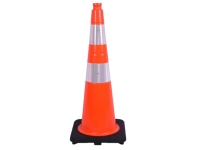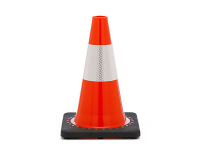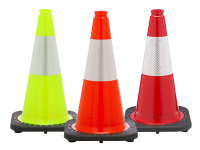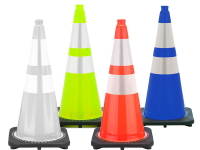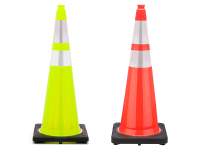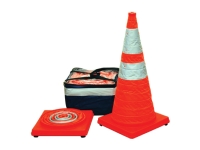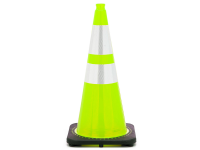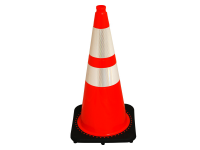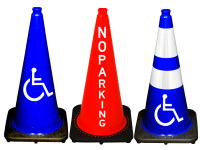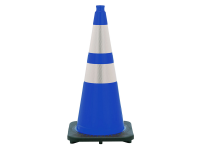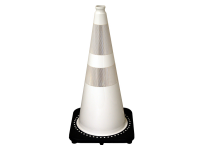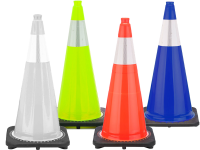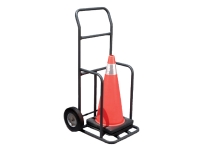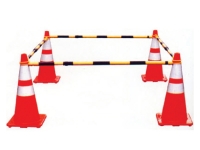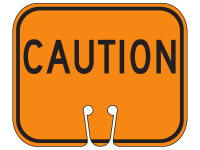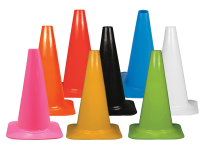Traffic Cones
Large Variety Of Colors & Sizes - Custom Cone Messaging Available
Additional Information
There's no doubt you've seen them on the roadside: those bright traffic cones that direct you where to go during highway construction.
You've driven past them countless times, likely not thinking too much about their placement or importance. Yet, there is more to this safety equipment than meets the eye.
Today, we're exploring the significance behind those neon cones, including what they mean, what they're used for and why they're some of the most critical pieces of safety gear around.
Ready to learn more? Let's get started.
What Exactly Are Traffic Cones?
Let's begin with a simple question: What are traffic cones in the first place?
In short, these are protective safety tools that are designed as channeling devices. According to the Manual for Uniform Traffic Control Devices, this means that they are specially designed to serve as a temporary guide for motorists traveling on public roads.
To be considered legal for road use, these cones must be constructed and molded from shock-absorbing plastic that's safer for cars than the materials used to build harder all-purpose cones. In addition, the Federal Highway Administration (FHA) requires that traffic cones meet certain specifications for:
- Height
- Color
- Luster
Where Are Different Traffic Cone Sizes Used?
Not all traffic cones are created equal. There are different heights and size categories used for different scenarios.
Let's explore the most common cone sizes.
Six Inch cones
You cannot legally use six-inch traffic cones on public roads. These are reserved for driver's education courses and to designate indoor hazards.
12 Inch cones
You cannot legally use 12-inch traffic cones on public roads. These are reserved for athletic events or to design courses for pet-related training.
18 Inch cones
You can use 18-inch traffic cones for roadways that have posted speed limits of under 45 miles per hour. They are most commonly used for parking lots, athletic events, and landscaping purposes.
28 Inch cones
Any traffic cone that is 28 inches high must include a heavy base that is at least 10 pounds. They are most commonly used as hazard markers, though they're also helpful as blockades.
36 Inch cones
Certain states, including Delaware and Florida, require traffic cones to be at least 36 inches tall. These cones are appropriate for roadways with posted speed limits of 45 miles per hour or greater.
The Usage of Traffic Cones
Traffic cones are used to designate what's known as Temporary Traffic Control Zones, or TTC Zones. This term is used to define any roadside area where normal conditions are changed.
The four main TTC Zone categories include:
- Work Zones
- Incident Zones
- Special Lanes
- Planned Events
Let's review each category in greater detail.
Work Zones
A work zone is any highway area where there are construction, maintenance or utility activities taking place.
Incident Zones
An incident zone is an area marked off by authorized personnel immediately after a traffic incident has occurred. It's established to prevent passersby from inadvertently entering into the incident zone.
Special Lanes
Any time that roadside personnel need to divide vehicular lanes to accommodate a different traffic flow, they'll use traffic cones to mark these special lanes. They do the same when they need to mark special lanes for bikers, pedestrians or cyclists.
Planned Events
Have you ever tried to drive through downtown during a street festival or a marathon? If so, you'll find that there are certain areas marked with traffic cones that you cannot drive through. These are placed before planned events to allow traffic to circumvent the main area of activity.
What Do Different Traffic Cone Colors Mean?
While most traffic cones are brilliant orange, you might also notice them in a wider range of colors. Let's take a look at what each one means and where you'll most commonly find that hue.
Brilliant Orange Traffic Cones
Brilliant orange traffic cones are used to designate TTC Zones.
Lime Green Traffic Cones
Lime green traffic cones mark an increase in nearby pedestrian activity, encouraging motorists to keep away. You might also notice them in front of key entryways.
Kelly Green Traffic Cones
Due to their color, Kelly green traffic cones are regularly used in outdoor athletic events, such as track and field games.
Royal Blue Traffic Cones
Royal blue traffic cones are visible in parking lots, often used to designate handicap-accessible parking spaces. If you're traveling in an area that has overhead wires, blue cones will also serve as a warning here, too.
Yellow Traffic Cones
Like yellow caution signs and caution tape, yellow traffic cones are used to warn nearby pedestrians of indoor hazards, such as a wet floor.
Jet Black Traffic Cones
Jet black traffic cones are often placed alongside brilliant orange traffic cones to provide contrast. They can also be used to guide traffic during a funeral procession.
White Traffic Cones
White traffic cones are used to designated valet parking spaces. Due to their clean and professional appearance, they can also be used to mark corporate displays.
Pink Traffic Cones
Their whimsical color makes pink traffic cones the ideal way to designate children's play areas. You might also see them more frequently during the month of October, where they help designate Cancer Awareness Month.
Dark Red Traffic Cones
Commonly used in warehouses and other high-risk facilities, dark red traffic cones help guide indoor machines around designated courses. They can also help isolate certain hazards from the rest of the workplace.
Purple Traffic Cones
Like pink cones, purple traffic cones are also frequently used for children's events, sports, and other indoor celebrations.
Alternative Types of Traffic Cones
In addition to the standard types and colors listed above, there are also a few different kinds of alternative traffic cones that have gained popularity in recent years. These include pop-up cones and hollow cone tubes.
Pop-Up Traffic Cones
When road flares aren't a safe or energy-efficient way to indicate emergencies, first responders can use collapsible, pop-up traffic cones instead. These energy-efficient cones are made of nylon and feature an LED bulb inside. In addition, some drivers will carry these in their vehicle to have on hand in case of an emergency, as they're easy to fold and store.
Hollow Cone Tubes
When crowd control is the intent, hollow cone tubes are ideal. Personnel will normally set these up to designate where lines begin and end and the route they should take. You can string tape between them, as well as chain or cone bars.
Find the Traffic Cones You Need Today
Are you looking for a wide variety of traffic cones to serve many different kinds of roadside needs? If so, we're here to help.
We carry a full line of cones, kits, lights, and other accessories. Once you find what you need, keep browsing to discover our full inventory of safety gear. If you have any questions, feel free to contact us.
Additionally, the reflective cones are often seen ahead and behind a disabled vehicle to warn other drivers that there is a stationary vehicle present in their path. Residentially, parents have taken to use them to warn drivers that a neighborhood event is taking place or there at kids at play. In essence, their usefulness to warn others to exercise caution is unlimited. Now available in many color choices, safety orange still remains the #1 color purchased because of the traditional association of Orange as a color of warning.
A little history about ‘traffic cones”: they were invented by an American by the name of Charles Scanion in 1943. They were originally made of concrete but with the advent of plastics technology, they are now primarily made with thermoplastics or rubber.


